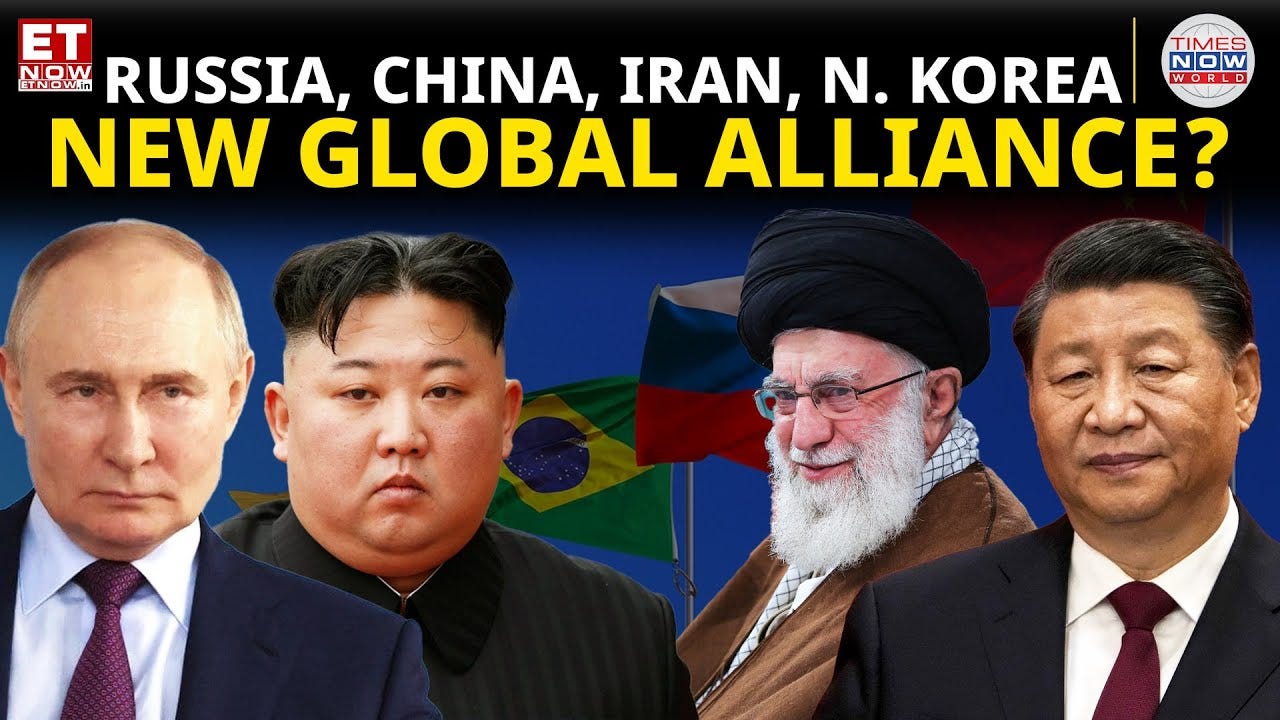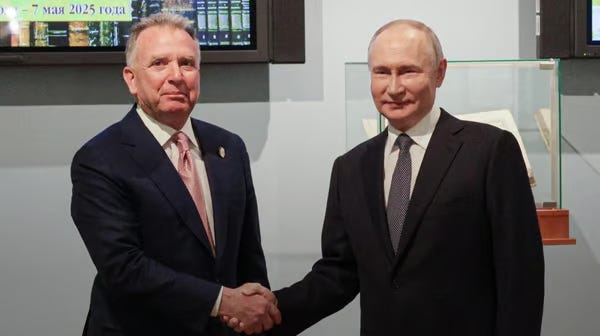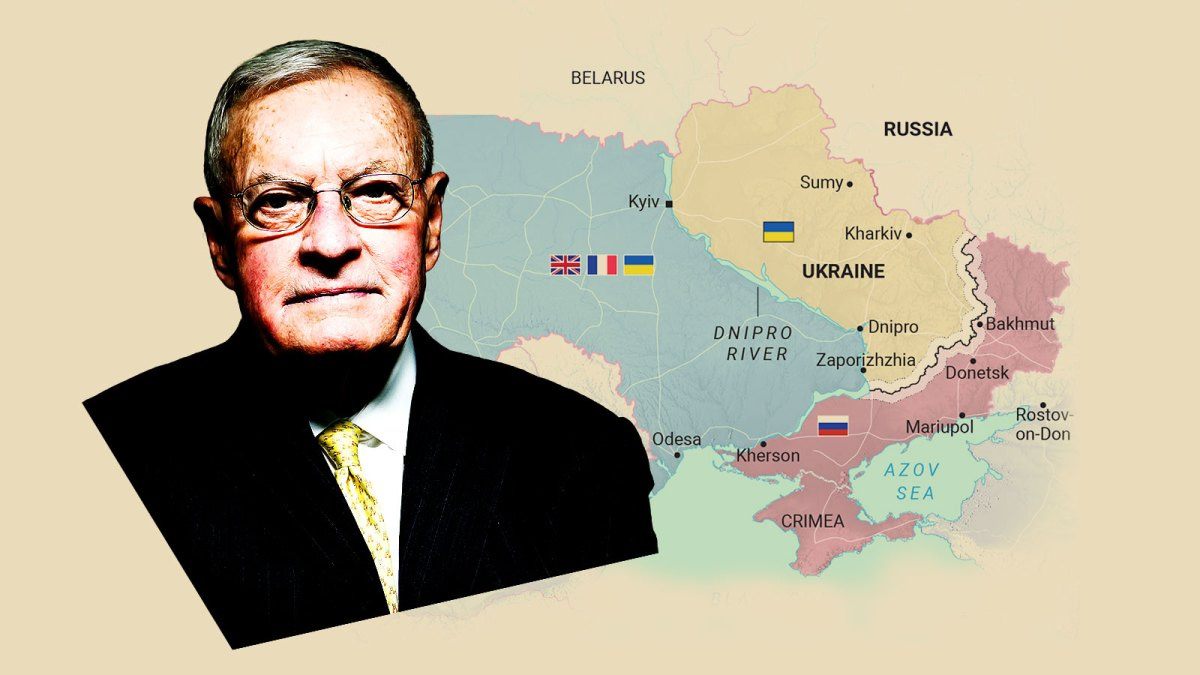America's Five-Front Trap
With Ukraine peace efforts dead, the U.S. now confronts five active fronts—against Russia, China, Iran, North Korea, and Yemen—with allies hesitant to share the burden.
Peacemakers earn their mantle in history—but not by fuelling a war for years before clutching at an inauthentic mediator’s cloak when the tide turns. The American bid to end Ukraine’s war collapsed this week, crushed under its own contradictions. For three years, Washington armed, advised, and ideologically incited Ukraine’s resistance; now, with Trump’s return, it postures as a neutral arbiter—refereeing a conflict between its most precious proxy and its existential rival. The spectacle borders on self-parody: a hegemon that spent years pouring gasoline on the fire now waves a ceremonial extinguisher. Only Iran brokering peace between Hezbollah and Israel could match such audacious absurdity.
Warmongers, too, earn their infamy—though their minds chart divergent paths to it. Putin, the autistic strategist, played the diplomatic theatre with glacial precision: humouring Trump’s good-cop envoy Steve Witkoff in courteous formalities while never loosening his grip on the war’s levers. His focus was fractal—obsessed with terrain, timelines, and the irrevocable. Trump, the ADHD tactician, spun spectacle, chasing the dopamine of short-term wins and televised breakthroughs. But Putin’s calculus was immutable: why trade the certainty of grinding victory for the flicker of a staged compromise? The hunter’s improvisation met the farmer’s endurance—and the field often favours the one who plants deepest.
This failed diplomatic pivot reeks not of strength but necessity—a player scrambling to freeze one corner of the board as others ignite. The West sought ceasefire not from leverage, but because Russia’s glacial advance, move by inevitable move, has tilted the game. Territorial gains blur like pawns traded mid-match; what matters is the clockwork pressure bending Ukraine’s defenses.
Washington’s goal was stasis—desperate to freeze these pieces in place before new threats erupted elsewhere. But patience is the ADHD strategist’s curse: Trump’s gaze darts from quadrant to quadrant, chasing gambits but never endings, while Putin’s autistic precision accumulates advantages like a grandmaster methodically trading pawns for position.
Ukraine’s remaining strength is fading into abstraction—less an army than a silhouette of its former self. Estimates suggest Russia has degraded much of Kiev’s combat capacity. This is the arithmetic of attrition: victories accrue not in thunderclaps but in silent percentages, their weight only felt when the structure buckles.
Moscow plays the long game—not for fields or cities, but for the bones of history itself. It seeks not just victory, but a verdict: a peace so deeply carved into the earth that no future American hand can pry it loose. And so the war grinds on—patient as stone, pitiless as winter—stretching across seasons and years toward its hardened conclusion. Russia’s hope is that when peace finally comes, it will come not just as a treaty, but as a tomb: sealed, silent, and everlasting.
Europe's rhetoric has shed its skin. Where once EU leaders proclaimed 'Russia's strategic defeat,' their podiums now murmur 'unconditional ceasefire'—a phrase draped in the faded grandeur of Churchillian grammar, but hollowed of conviction. To distant ears, it may still resonate with the old refrain of 'unconditional surrender.' But the truth hums beneath the syllables: Brussels negotiates not from strength, but from the quiet exhaustion of a player who knows the game is lost. The West's victory liturgy has become a requiem.
Kellogg Plan
The so-called Kellogg Plan dangled meagre concessions before Moscow—not as recognition of Russia’s approaching victory, but as diplomatic misdirection. Vague nods to Crimea’s status, partial sanction relief, and hollow restrictions on NATO expansion are illusions, fleeting as the next U.S. election cycle.
European "reassurance forces" along with Ukrainian forces would dig into 80% of pre-2014 Ukraine, transforming ceasefire lines into fortified frontiers. Trenches would spiderweb the landscape; armouries bulge with fresh weaponry; a revanchist Ukrainian army coalesces in the twilight between peace and renewed war. Every loss Russia inflicted through three blood-soaked years would be methodically reversed—not to restore balance, but to prime the springboard for Donbas’s reconquest.
Herein lies the trap: A "frozen" conflict that freezes only the surface, while beneath it, the West re-forges the very hammer meant to shatter Russia’s gains.
Beneath the frenetic diplomatic theatre thrums America’s glacial calculus. A Korean-style armistice in Europe serves U.S. interests not despite perpetuating hostility, but because of it. This is no strategic failure—it is the execution of Mackinder’s century-old imperative: fracture Eurasia’s cohesion at any cost.
Now, as the EU pivots toward Beijing amid escalating trade wars, a durable Ukrainian peace threatens to unlock the ultimate geopolitical nightmare: a continental embrace between St. Petersburg, Berlin, and Beijing. Washington’s objective is neither victory nor peace, but controlled disequilibrium—conflicts frozen across the Eurasian chessboard, their pieces preserved for timed activation. Ukraine is but one square; elsewhere, from Taiwan to the Levant, pawns smoulder in deliberate suspension.
This is strategic sequencing at its most ambitious: the deliberate staggering of crises to avoid multifront collapse. Yet the approach demands near-impossible discipline—a quality alien to Washington’s current diplomacy. For all its grand design, America now plays the game like a sleep-deprived tactician, fumbling to freeze one conflict even as its rivals ignite three more. The theory is sound; the executors have yet to prove they are up to the challenge.
Putin’s Path: Peace Through Victory
Nearly a year ago, Russia laid out its terms for ending the war in Ukraine. On June 14, 2024, before a formal gathering at the Russian Foreign Ministry, President Vladimir Putin delivered a speech outlining the conditions under which Moscow might agree to halt its military campaign:
These conditions are simple. The Ukrainian troops must be completely withdrawn from the Donetsk and Lugansk People’s Republics, as well as from the Kherson and Zaporozhye regions... from the entire territory of these regions within their administrative borders at the time they were part of Ukraine.
As soon as Kyiv declares its readiness to make this decision and begins a real withdrawal of troops from these regions, and also officially renounces its plans to join NATO, our side will issue an order to cease fire and begin negotiations—immediately.
We will guarantee a safe and unhindered withdrawal of Ukrainian units... We expect Kyiv to adopt these decisions independently, in line with national interests—not under Western direction, although we have serious doubts about that.”*
In effect, Putin’s demands amount to a Ukrainian retreat—not only territorially, but ideologically: a renunciation of NATO membership, a formal acceptance of territorial losses, and a shift toward neutrality. By withdrawing from these regions, Ukrainian forces would be symbolically and strategically acknowledging Russian dominance.
While Russia undeniably holds the strategic initiative, the battlefield as of May 2025 presents a paradox: Moscow's advances remain too modest to force Ukrainian capitulation, yet relentless enough to make Kiev's position untenable. The recapture of Kursk serves as a morale booster, but critical Donbas cities like Kramatorsk and Sloviansk still fly Ukrainian flags - a glaring incompleteness in Putin's victory narrative.
This is war by erosion rather than explosion: Russian forces advance not with blitzkrieg breakthroughs but through the slow, metronomic destruction of Ukraine's fighting capacity. The frontlines tell two stories - one of Russian momentum, the other of stubborn Ukrainian resistance - with neither side yet able to write the final chapter.
“We repeat our firm stance,” Putin emphasized in his address. *“Ukraine must adopt a neutral, non-aligned status, be nuclear-free, and undergo demilitarisation and denazification. These parameters were broadly agreed during the Istanbul negotiations in 2022—including specific limits on tanks and military equipment.
The rights of Russian-speaking citizens must be protected, and the new territorial realities—Crimea, Donetsk, Lugansk, Kherson, and Zaporozhye—must be acknowledged as part of the Russian Federation. These terms must be formalized through international agreements. Naturally, this entails the removal of all Western sanctions against Russia.”*
Western observers often brand these demands as “maximalist,” yet within Moscow they are regarded as minimal—baseline conditions for any enduring stability. Chief among them is “demilitarization,” which would drastically limit Ukraine’s armed forces and place any foreign troop presence under de facto Russian veto. “Denazification,” meanwhile, would mean not only the marginalization of Ukraine’s nationalist right but also the installation of a government more aligned with Russian interests—an arrangement resembling the political model seen in Belarus.
However, some of Putin’s demands—though crafted to appear reasonable to sympathetic allies—seem deliberately calibrated to be unacceptable to Western adversaries. The full lifting of sanctions and formal recognition of Russia’s claim to the five occupied oblasts would be politically toxic for any independent Ukrainian leadership and nearly impossible for Western governments to accept without appearing to capitulate. In essence, these terms are less a genuine offramp and more a means of prolonging the war—buying time for Russia to secure a decisive victory on its own terms.
Retired U.S. Lt. Gen. Keith Kellogg inadvertently describes some of the actual conditions for a true Russian victory:
Russia is not winning this war. They haven’t taken Kyiv. They haven’t crossed west of the Dnipro. They haven’t taken Odesa. They’ve lost hundreds of thousands of soldiers and gained little. The war moves by meters, not miles. The Ukrainians are fighting hard—on their own soil.
The subtext of Putin’s demands is stark Ukraine’s choice is to cede five oblasts today—or lose nine tomorrow. The implied warning is that if Kiev refuses to submit now, it risks the eventual fall of even more territory—Odessa, Kharkov, and the mineral-rich Dnepropetrovsk region—once its army collapses under the slow, grinding weight of attrition.
Minerals Deal
On April 30, 2025, the United States finalized the much discussed minerals deal with Ukraine, marking a new chapter in economic cooperation. U.S. Treasury Secretary Scott Bessent and Ukrainian Economy Minister Yulia Svyrydenko signed the agreement, which aims to secure American access to Ukraine’s critical minerals and support its reconstruction efforts.
The deal has little to do with shaping post-war Ukraine and everything to do with giving Trump political cover as he pivots back toward President Biden’s Ukraine policy. It offers the thinnest of fig leaves—a cosmetic “investment” framework that allows the resumption of arms transfers under the guise of a new approach. To his most loyal supporters, it can be spun as an “Art of the Deal” success; to the foreign policy establishment, it signals reassuring continuity.
But for more discerning MAGA partisans, the pivot may feel like betrayal: they didn’t vote for Trump to oppose the Ukraine war for just a hundred days, only to return to the Biden-era strategy of arming Kiev and sanctioning Moscow into submission.
America’s Strategic Dilemma: Five Fronts and False Friends
On the global stage, the United States faces a gathering storm—the very real prospect of a five-front confrontation with a revisionist bloc comprising Russia, China, Iran, North Korea, and Yemen. Trump’s tentative overtures to Moscow were never about idealism; they represented cold pragmatism, an attempt to break this dangerous simultaneity before it congealed into open conflict. Yet the fundamental imbalance remains: while serious doubts persist about America’s ability to decisively defeat even one of these adversaries in isolation (could the U.S. sustain a ground war in Iran, let alone Yemen?), the spectre of fighting all five at once guarantees catastrophic overstretch—potentially triggering outright strategic collapse.
America’s so-called "allies" have become liabilities masquerading as partners. The European Union’s militaries, hollowed out by decades of defense free-riding, are little more than glorified gendarmeries—capable of colonial-style pacification but useless in great-power conflict. Japan and South Korea, despite their wealth and technological sophistication, remain politically brittle and culturally allergic to the sacrifices real war demands. Even Israel, long vaunted as Washington’s most battle-tested ally, has revealed glaring limitations—failing to dismantle Hezbollah’s defenses in ground combat while relying on airstrikes and decapitations that generate more headlines than strategic gains.
America's allies have proven themselves fair-weather partners at best. Repelled by Trump's tariff wars and transactional diplomacy, Europe, Japan and South Korea have increasingly sided with China on trade issues - prioritizing short-term commercial interests over the alliance cohesion that has secured their prosperity.
This alignment with China reflects tactical hedging rather than strategic abandonment—the behaviour of frustrated partners, not revolutionaries. Like a medieval court awaiting a new king, they bide their time until Washington returns to predictable leadership. But the damage to American credibility lingers. When tested by multifront crisis, these allies would likely hesitate—not out of malice, but from atrophied trust and competing priorities. The result is an America forced to wage its most consequential fights while glancing over its shoulder at partners who may arrive late, or not at all.
The Revisionist Playbook: Pinning America in Perpetual Overstretch
From Moscow to Beijing, the strategy is transparent: force Washington into a state of exhausting simultaneity. Russia and China have already turned Ukraine and Yemen into bleeding wounds, sapping U.S. resources while their economic warfare compounds the pressure. Iran looms as the next flashpoint, with hardliners in Washington and Tel Aviv seeking to sabotage diplomacy. Even North Korea—once a wild card—now operates as a coordinated player, aiding Russia against Ukraine while waiting for its moment to strike should other fronts ignite.

The revisionists understand America’s fatal weakness: it lacks the discipline to sequence its conflicts. Like a martial artist surrounded by foes, the U.S. must defeat adversaries one by one—yet Washington’s foreign policy priesthood, drunk on myths of unipolar dominance, rejects any temporary accommodation as "appeasement." Their maximalist posturing plays directly into the revisionists’ hands, ensuring the U.S. stays stretched thin across every theatre.
The hawks’ fatal conceit lies in believing America can pummel a united revisionist bloc while dragged down by reluctant allies. But grand strategy obeys iron laws: pride demands simultaneity, simultaneity guarantees overload, and overload ends in imperial collapse. There are only two exits from this trap.
The first is the path of brute force—shedding deadweight allies and fighting sequenced wars with Spartan discipline. The second, wiser course revives an older wisdom: the art of disinterested hegemony. Like medieval monarchs who arbitrated between dukes rather than conquering them, America could return to managing—not provoking—global tensions. This demands withdrawing from crusades, letting rivals check each other, and rebalancing the system when any power grows too bold.
The choice is stark: bleed out from five simultaneous wounds, or reclaim the throne above the fray. The first requires impossible ruthlessness; the second, nearly impossible restraint.






Kevin,
an excellent piece. But I would like to see the sequel, and an attempt to answer the big question:
How will the war end?
With details and various scenarios.
Great analysis, love it.